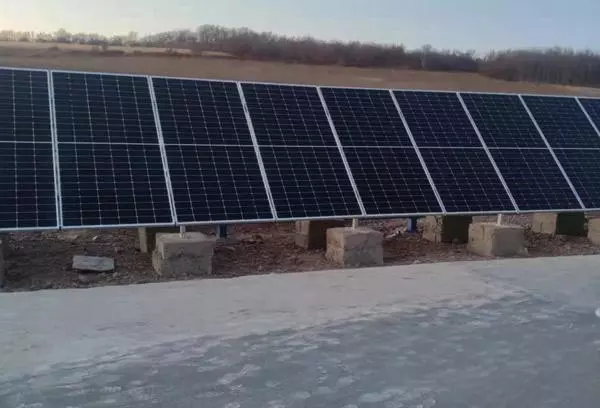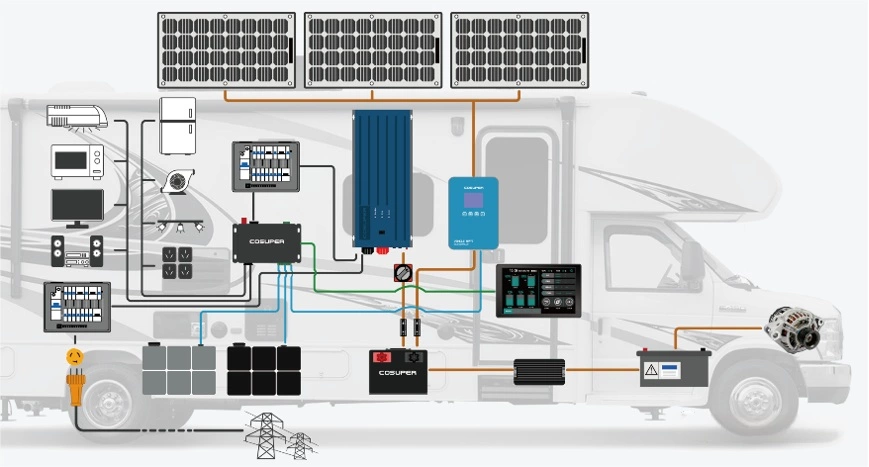1. What is a PV energy storage power station?
A: A PV energy storage power station is a power station that integrates a photovoltaic power generation system with a solar battery. It can store excess energy during the power generation process and output it for use when needed.
2. What is the basic working principle of a PV energy storage power station?
A: Solar panels convert solar energy into electricity. An inverter converts DC power into AC power. Some of this energy is used by the load, and the excess is stored in a solar battery. When photovoltaic power generation is insufficient or there is no sunlight, the battery storage releases this energy to the load.
3. What are the main components of a photovoltaic energy storage system?
A: It mainly consists of solar panels, inverters, battery storage, and an energy management system.
4. What is a solar panel? What is its function?
A: A solar panel is a unit composed of multiple solar cells assembled and packaged together. Its main function is to convert solar energy into DC power.
5. What is an energy storage battery? What are the common types of energy storage batteries?
A: An battery storage is a device used to store electrical energy. Common types include lithium ion solar battery, lead-acid batteries, and flow batteries.
6. What is an inverter? What is its function in a photovoltaic energy storage power station?
A: An inverter is a device that converts direct current (DC) to alternating current (AC). In a photovoltaic energy storage power station, the DC power generated by photovoltaic panels is converted into AC for use by loads or fed into the grid.
7. What is an energy management system (EMS)? What are its functions?
A: An EMS is a system that manages the energy of a photovoltaic energy storage power station. Its functions include monitoring the power station's operating status, controlling charging and discharging, and optimizing energy distribution.
8. What does "capacity ratio" mean in a photovoltaic energy storage power station?
A: It refers to the ratio of the installed capacity of the photovoltaic power station to its energy storage capacity.
9. How do we understand the "on-grid power" and "self-consumption power" of a photovoltaic energy storage power station?
A: On-grid power refers to the power supplied by the photovoltaic energy storage power station to the power system; self-consumption power refers to the power consumed by the power station's internal equipment or loads.
10. How do I choose the right solar panels? What factors should I consider?
A: Factors to consider include conversion efficiency, power output, reliability, cost-effectiveness, and warranty period.
11. What are the advantages and disadvantages of different types of solar batteries? How should I choose based on the application scenario?
A: Lithium ion solar batteries have high energy density and long lifespan, but are more expensive; lead-acid batteries are less expensive, but have lower energy density and shorter lifespan. The choice should be based on the energy requirements, cost requirements, and space constraints of the application.
12. How should I choose the right inverter? How should its power and performance parameters be matched?
A: The choice should be based on the power and load requirements of the PV modules. When matching, consider parameters such as the inverter's rated power, efficiency, and input and output voltages.
13. What are the key technical indicators and functional requirements for energy management systems?
A: Technical indicators primarily involve accuracy and response time; functional requirements include monitoring, control, and optimized scheduling.
14. How should I select cables for a PV energy storage power station? What should I consider?
A: The selection should be based on current and voltage levels. Consider insulation performance, heat resistance, and aging resistance.
15. How do I choose a suitable transformer? How do I determine its capacity and transformation ratio?
A: The selection depends on the power plant's output power and grid-connected voltage requirements. The capacity is determined by the load and reserved capacity, and the transformation ratio is determined by the input and output voltages.
16. What monitoring equipment is used in energy storage power plants? How do I choose a reliable monitoring system?
A: Monitoring equipment includes power sensors and temperature sensors. When selecting a reliable monitoring system, factors such as accuracy, stability, and compatibility with other equipment should be considered.
17. What are the site requirements for a solar energy storage power plant?
A: The site must meet requirements such as sufficient sunlight, no obstructions, flat terrain, and a safe distance from flammable materials.
18. What are the different installation methods for photovoltaic panels? What are their respective application scenarios?
A: Fixed and tracking. Fixed installations are low-cost and suitable for general applications; tracking installations can increase power generation and are suitable for areas with abundant sunlight.
19. What safety precautions should be taken when installing energy storage batteries?
A: Ensure good ventilation, stay away from fire sources, prevent collisions, and connect correctly.

20. What are the requirements for the inverter's installation location and environment?
A: Dry, well-ventilated, with good heat dissipation and away from flammable materials.
21. How should cables be laid and connected? What are the relevant construction specifications?
A: Cables should be laid neatly and securely, avoiding crossovers. Connections should be secure and reliable, complying with electrical specifications.
22. How should lightning protection and grounding be implemented during installation?
A: Lightning rods and grounding grids should be installed to ensure that the grounding resistance meets the requirements.
23. What are the construction acceptance standards for photovoltaic energy storage power stations?
A: The standards to be followed cover multiple aspects, including electrical safety, installation quality, and performance indicators.
24. What are the daily operation and maintenance tasks for photovoltaic energy storage power stations?
A: Daily maintenance tasks include checking the operating status of the equipment, cleaning the photovoltaic modules, and monitoring the performance of the batteries.
25. How should photovoltaic panels be cleaned and maintained? How often should they be cleaned?
A: Use clean water or a specialized cleaning agent. The frequency of cleaning depends on the environment, but is generally once a quarter.
26. What precautions should be taken when managing the charge and discharge of solar batteries?
A: Avoid overcharging and overdischarging, control the charge and discharge currents, and maintain a suitable temperature.
27. How should the operating status of the inverter be monitored? What are common faults and how are they handled?
A: Through the monitoring system. Common faults include overheating and overload. Repairs or component replacement are performed based on the type of fault.
28. What precautions should be taken when performing routine maintenance and parameter settings on the energy management system?
A: Regular maintenance tasks include checking for software updates, ensuring all parameter settings are correct, and backing up important data.
29. How should the energy efficiency of a photovoltaic energy storage power station be evaluated and performance optimized?
A: Monitor data such as power generation and power consumption, analyze efficiency, and optimize equipment operating parameters.
30. How should a photovoltaic energy storage power station respond to severe weather conditions (such as heavy rain, strong winds, and lightning)?
A: If necessary, equipment should be shut down for a comprehensive inspection, lightning protection and grounding measures should be strengthened, and drainage systems should be unobstructed.
31. What does the conversion efficiency of a solar panel mean? How can this efficiency be improved?
A: Conversion efficiency measures the ability of a photovoltaic module to convert solar energy into electrical energy. Methods for improving efficiency include using high-efficiency cells and optimizing the packaging process.

32. What do parameters such as energy density, cycle life, and charge/discharge rate of energy storage batteries mean?
A: Energy density is the amount of energy stored per unit volume or weight of a battery; cycle life is the number of times a battery can be charged and discharged; and charge/discharge rate is the ratio of the charge/discharge current to the rated capacity.
33. How do inverter parameters such as efficiency, power factor, and harmonics affect power station performance?
A: Efficiency affects energy conversion losses; power factor affects grid stability; and harmonics can interfere with the grid and other equipment.
34. How is the system efficiency of a photovoltaic energy storage power station calculated?
A: System efficiency = output power / input solar energy.
35. How is the installed capacity and energy storage capacity of a photovoltaic energy storage power station determined?
A: It is determined based on factors such as load demand, sunlight resources, and budget.
36. How do the charge and discharge times and power of the energy storage power station match the power generation characteristics of the photovoltaic power station?
A: Based on the output power curve of the photovoltaic power station and the actual load demand, the charge and discharge periods and power configuration of the energy storage batteries are scientifically planned.
37. What policy support is provided for the construction and operation of photovoltaic energy storage power stations?
A: Incentives include subsidy policies, feed-in tariff mechanisms, and tax exemptions.
38. What are the grid-connection standards and requirements for photovoltaic energy storage power stations?
A: Comply with the grid's voltage, frequency, power factor, and other requirements, and have protective devices and communication capabilities.
39. What approval procedures and licenses are required for the construction of an energy storage power station?
A: Project filing, planning permits, construction permits, etc.
40. What are the subsidy policies for photovoltaic energy storage power stations? How do I apply for subsidies?
A: Subsidy policies vary by region. Generally, you can apply to your local energy management department.